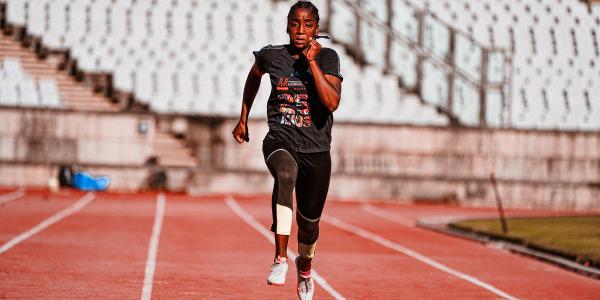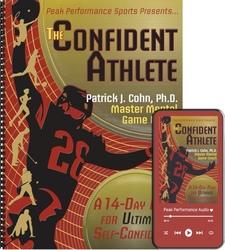
Do Worrisome Thoughts Affect How you Perform?
Do you tend to worry about letting your teammates down or having a bad game?
Athletes who worry think too much about past poor performances or possible negative future results. Worrying about something that has yet to happen interferes with an athlete’s ability to perform at their peak.
For example, an athlete who tweaked their hamstring in their last competition may worry about a more significant injury in their next game.
These worrisome thoughts may cause the athlete to play cautiously. The player may hesitate to go for a 50-50 ball or slide tackling to break up a play.
Here’s another common scenario in basketball. A player who averages 20 points a game is worried about playing in his first high school playoff game.
Negative images consume him. He worries about missing shots and making mistakes during the game. He fears he will be the reason his team loses and fails to advance further in the playoffs.
So, instead of taking open shots, he passes the ball to his teammates. Throughout the game, he’s indecisive with the ball in his hands and turns over the ball frequently.
Worry is a mental block that prevents you from performing freely.
You experience worry in four ways:
- Thoughts – Worry causes you to ruminate about the past or future. Worrisome thoughts include, “What if I mess up like I did the last game? I just can’t get back on track. If I have another bad game, my teammates will blame me for losing.”
- Images – When you worry, you will replay scenes in your mind of failing, losing, or making mistakes. You will see yourself failing again in the present.
- Emotions – Worry increases the amount and intensity of performance-interfering emotions, such as fear, anxiety, frustration, anger, and doubt.
- Physical – Worry manifests in various physical symptoms that detract from athletic performance, such as restlessness, upset stomach, muscle tightness, sluggishness, and racing heart rate.
Athletes who worry become frustrated when they miss a shot, make a mistake or start slow in a competition. They tend to have difficulty making quick, precise decisions.
They start competitions slowly or find it challenging to get into a rhythm. Athletes who worry are pessimistic about how they will perform and have an avoidance mindset.
You can use your thoughts, images, emotions, and physical sensations as an early detection system.
When you notice you are thinking about making mistakes, counter those negative thoughts with productive thoughts such as, “Stay focused. I’ve got this!”
When you see images of failing, try to visualize success or see yourself making a positive impact during the competition.
When you initially feel nervous or experience anxiety symptoms, you can take several deep breaths to quiet your mind and calm your body.
Overcoming Negative Thoughts
The key to stop worrying is to get out of your own head. Elite athletes combat worry using several mental strategies such as deep breathing, mindfulness, muscle relaxation, or focusing on their game plan.
New York Liberty guard Sabrina Ionescu, the No. 1 overall pick in the 2020 draft, had a slow start to the 2023 WNBA season.
Instead of worrying about misses and bad games, Ionescu focuses on executing her role on the court and trusting her ability to score.
After a record-breaking performance in the 3-point competition during the WNBA All-Star weekend, Ionescu has been a model of consistency. After the All-Star break, Ionescu went on a tear making 50 3-pointers during a string of games.
IONESCU: “I’m just playing basketball. I’m just continuing to trust my shot and my shooting ability. I come out every game with the same mentality, and that is to do my job and to do it to the best of my ability.”
Worry is a thought, and you have the ability to change your thoughts. As your thoughts change, so will your emotions and your performance.
The first step in combating worry is to identify your triggers. That is, what circumstances or events cause you to worry?
When you create a list of triggers, you can then develop solutions for each trigger. This means how you will react with composure to each trigger.
For example, if you worry about missing shots (after missing), you want to think about and visualize the ball going into the basket and what that feels like.
Avoidance thinking will only lead to tentative play.
Related Sports Psychology Articles
- Why Athletes Worry too Much About What Others Think
- How to Develop a Clutch Mindset
- Sports Psychology Podcast: How to Stop Worrying About What Coach Thinks
*Subscribe to The Sports Psychology Podcast on iTunes
*Subscribe to The Sports Psychology Podcast on Spotify
Download a free sports psychology report to improve your mental game!
Learn more about our one-on-one mental game coaching.
The Confident Athlete

“The Confident Athlete” consists of 2 audio programs that include 14 days of confidence fueling exercises and a simple to follow workbook that guides you through the 14 days, helps you apply the strategies, and customizes the exercises to your personal needs.
Let me help you put a stop to the confidence leak. You can learn to have greater levels of confidence in competition than you do in practice by identifying the specific ways you undermine your own confidence and how to convert your practice confidence into COMPETITIVE CONFIDENCE.
“The Confident Athlete” is a ground-breaking system to teach you how to think like a champion and have ultimate self-confidence every time you step on the playing field, court, track, or course. The confident athletes was developed for any athlete – junior to professional –that wants to gain confidence. However, coaches and sports parents can learn how to teach others to perform with ultimate confidence. Use my program if you want to bust a slump or just wanting higher or more consistent levels of self-confidence.
